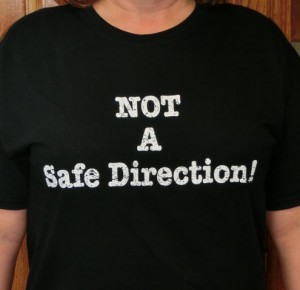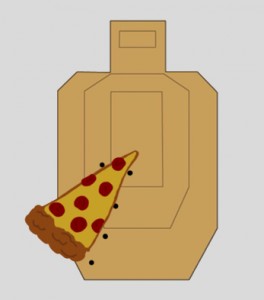From time to time, people ask me what else I carry with me every day when I leave the house.
Of course there’s the firearm (a Glock 26 in 9mm) in its holster (a straight-drop, single attachment tuckable Kydex holster from Custom Carry Concepts), which I tote in the appendix position on my belt (a contoured, tapered one from Galco). That part is easy, because I’m fortunate enough that I can wear jeans most days. On days when pants with belt loops aren’t possible, I often opt for a belly band (a PT2 from Pistol Wear). Of course, that’s when I’m not trying out some new holster or carry method so I can tell my students about it.
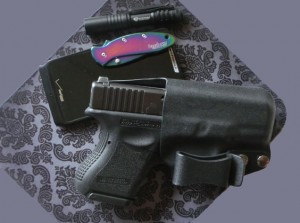
Everyday stuff.
*yawn* It’s a gun. I carry it. That’s all good.
But day in and day out? I’m far more often to need or want some other tools to get through the day.
Phone
Of course there’s the cell phone. Most of us can’t live without one of those anymore (how did we ever…?) It can be an indispensable emergency tool – useful for dialing 911, contacting loved ones after an accident, looking up how to stop the bleeding or where to find a good sushi bar.
You almost certainly already know that when you call 911, you always give them your location first, even before telling them why you’re calling. This goes triply-true for calling from a cell phone which might get disconnected at any moment! From a cell phone, you never really know which emergency services department will pick up your call, so you should always tell the dispatcher the town and state along with the basic address.
Speaking of addresses, do you know where you are, right now? Can you recite the street address for your place of business, for your favorite coffee shop, for the grocery store where you always shop? Can you name the major cross streets to the park where you walk with your kids, or to your favorite restaurant? Get in the habit of noticing and remembering such things and you’ll be ahead of the safety game.
Cell phones have their downsides for the safety-minded, however. They can distract you, tempting you into ignoring the world around you when you really shouldn’t. You might be slightly more alert than the poor woman who walked into a nest of rattlesnakes while she was on her phone, but you’re probably not. You probably just live somewhere without rattlesnakes – but with cars, sneak thieves, and panhandlers instead. Or homicidal maniacs on public transportation. Hmmmm… Maybe it’s best to save your cell phone use for times and places where it’s truly safe to ignore the world around you.
So that’s the skinny on the cell phone. If I accidentally leave my cell phone on the night stand, I’m turning around to get it – no question. It’s a high priority.
Light
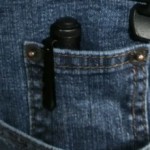
Small pocket, small flashlight. A match made in heaven.
Another high priority item I carry with me: the flashlight. The first time someone told me I should carry a flashlight all the time, I thought they were nuts. Now? I wouldn’t leave home without it. Just like the cell phone, if I unintentionally leave my flashlight behind, I’m headed back to get it.
It turns out that living with a flashlight in your pocket is a lot like getting a microwave oven for your kitchen. Yes… sigh… I just told you how very old I am, because I remember life before microwaves! My mom bought our first microwave oven when I was in fourth grade. I remember my parents talking about it at the dinner table one night, a few weeks before they splurged on the purchase. Neither one of them could picture a real need for it, but eventually they agreed it was a fun enough idea that it was worth trying. We did, and within a few months nobody in the house could imagine life without it anymore. We were hardly alone, either. When was the last time you saw a home without one? An always-with-you flashlight is something like that: unnecessary and slightly ridiculous before you own one, and indispensable once you’ve tried it.
Before I kept a flashlight in my pocket, I used to walk to my car after dark using just the ambient light in the lot – which means that sometimes I’d trip into a pothole even though I could see my car just fine under the streetlight. Walking through a parking garage, or crossing the street after dark, was much riskier too because car drivers couldn’t see me easily. During the day, when something rolled into the shadows behind my desk, I would blindly reach in and poke around without being able to see what I was doing, getting who-knows-what all over my hands in the process. When I woke up in the night while my husband slept nearby, I would either have to turn the light on (waking him) or stumble around in the dark tripping over things (waking him). When I needed to dig something out of the bottom of my gym bag or the back end of the filing cabinet, I’d have to rummage for it without being able to really see what I was doing.
Since then? Having a handy little light that I keep with me all the time has changed all that.
A few weeks ago, I was at the city library with a friend when the power suddenly went out all over the county. We were in the back part of the library, well back in the stacks, and with the power out it was pitch dark even though it was only mid-afternoon. Several people near us sounded on the edge of panic, including one young girl who couldn’t find her mom. So I reached into my pocket, hauled out my flashlight, and lit up the area. The girl found her mom, and all of us walked to the door together. No big deal – but I was happy that I had the tools to make an uncomfortable situation just a little more comfortable for everyone involved including myself.
A friend of mine has a more chilling tale. She was walking to her car after work when a scruffy-looking man started following her. Was he up to no good, or just a worker on his way home after a hard day? Was he a panhandler? A mugger? Just a neighbor walking to his car at the same time she was walking toward hers? She couldn’t tell, but she definitely caught some bad vibes from him as he followed her, watching her with a little too much intensity and coming a little too close to her as they moved through the otherwise empty lot. She already had her flashlight in hand as she walked, so she simply flicked the light on, shined it into his face and said, “Do I know you? Why are you following me?” He immediately turned around and walked back toward the buildings, cussing the whole way. Problem solved.
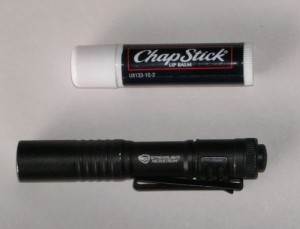
Yes, it really is that small.
Truthfully, I actually carry two flashlights most of the time: one small enough for the pocket, and a slightly larger and brighter one for my purse. The one in my pocket throws about 30 lumen, which isn’t much. But it’s about the size of a tube of Chapstick and takes a single AAA battery, which makes it a fabulous little tool. That’s a Streamlight Microstream, and it’s been good to me. During the day, I often unscrew the tailcap just slightly so I don’t accidentally bump the light on and run the battery down. Probably an excess of caution on my part, since it has a stiff switch anyway – but my friend Grant Cunningham once set his pocket on fire with an older technology flashlight, and I’ve been cautious about accidental activation of my lights ever since.
To answer one question that often comes up: if I’m walking to my car, the flashlight is prepped and in my hand, not in my pocket or purse where it’s slower to get.
Knife
Then there’s the knife. I carry it with me most days, but it’s frankly a lower priority than the other items. If I accidentally leave it on the nightstand, it’s probably staying there because I’m unlikely to turn around to get it.
The knife has sentimental importance to me: good friends have given me every knife I’ve ever carried, including my current favorites: a Ken Onion-designed Leek or Chive from Kershaw. Most often, I carry the Chive because it’s shorter and women’s pants pockets are annoyingly short. When I have short pockets, the longer knife sometimes jumps out of my pocket when I sit down, so I only carry it when I’m wearing pants with deeper pockets. Both of them are beautiful little tools, and I love the rainbow titanium finish of the ones I’m using these days.
My knife comes in handy fairly often during the day – for opening boxes, cutting string, getting into a package or slicing up a snack while we’re on the road. You’d be surprised how often you need a knife for things like that.
Yes. That’s what I said. Unlike many of my people, I often use my pocket knife as a simple tool and don’t get obsessive about protecting its edge. (Although of course I sharpen it from time to time!) For me, a knife is a functional cutting implement, and I use it for a million things.
Except as an absolute last resort, the knife is not really part of my defensive plans. In part, that’s because I already have a lethal-force option (the gun). People tend to think of knives as lesser weapons, as less-lethal force, but that’s not true. They are per-se deadly weapons in almost every jurisdiction I can think of. Using a knife is using deadly force. Those who have trained in knife defense, and those who have seen the results of knife attacks, know exactly how serious knives can be. Like firearms, they are deadly weapons.
The knife can be an excellent defensive tool for those who have trained with it. However, it’s not a lower level of force than using the gun, so it’s a redundant tool in that department. Not only that, but it requires you to get within close arm’s reach of your attacker, and using it requires a very personal commitment to violence. It’s an extremely messy weapon, and using it means you will definitely expose yourself to any bloodborne pathogens your attacker might carry. Statistically, using a knife for self defense creates a higher risk of injury or death to yourself – a risk you can and should reduce with good training.
My knife functions as a back up to the gun, but it’s not a serious alternative to the gun. It’s simply a potential last-ditch rescue tool if the gun fails for some reason. Speaking of last-ditch rescue tools, I keep a spare knife near my driver’s seat, and another in the glove box. Useful for cutting a seat belt, should it come to that.
What have you got in your pocketses?

